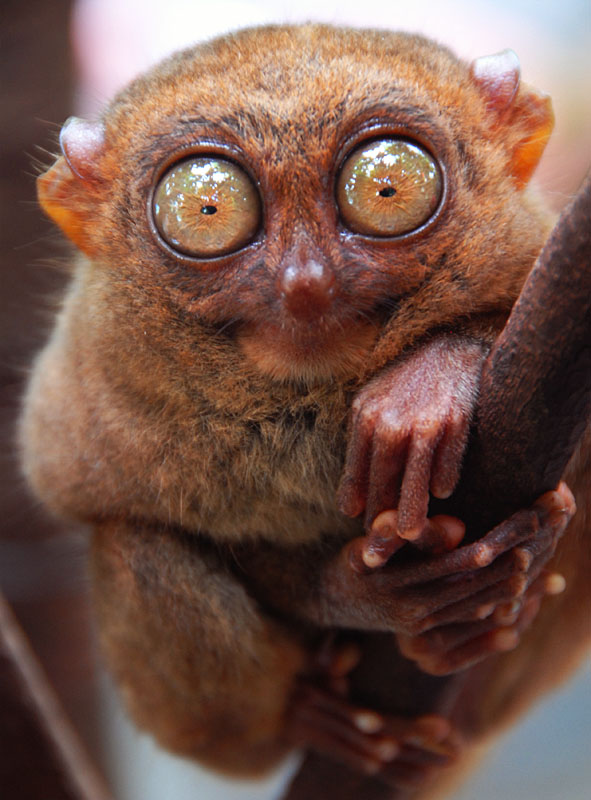|
| Query: Lariang tarsier | Result: 2nd of 2 | |
Tarsier (Family: Tarsiidae, Genus: Tarsius) - Wiki
| Subject: | Tarsier (Family: Tarsiidae, Genus: Tarsius) - Wiki
| |

| Resolution: 591x800
File Size: 142279 Bytes
Date: 2006:01:24 20:26:43
Camera: NIKON D200 (NIKON CORPORATION)
F number: f/5.7
Exposure: 10/100 sec
Focal Length: 2000/10
Upload Date: 2007:10:08 14:50:06
|
Tarsier
From Wikipedia, the free encyclopedia
[Photo] Philippine Tarsier (Tarsius syrichta). This is the tarsier, one of the smallest primates in the world, found only in the Philippines, on the island of Bohol in central Philippines and in Sarangani province on the island of Mindanao. They are very small, they can roll into a ball that can fit into your hand. They're awfully cute, spooky but cute. They look like yoda, really. Picture taken January 24 2006 http://www.flickr.com/photos/kenilio/117998881/
Tarsiers are prosimian primates of the genus Tarsius, a monotypic genus in the family Tarsiidae, which is itself the lone extant family within the infraorder Tarsiiformes. The phylogenetic position of extant tarsiers within the order Primates has been debated for much of the past century, and tarsiers have alternately been classified with strepsirrhine primates in the suborder Prosimii, or as the sister group to the simians (=Anthropoidea) in the infraorder Haplorrhini. Analysis of SINE insertions, a type of macromutation to the DNA, is argued to offer very persuasive evidence for the monophyly of Haplorrhini, where other lines of evidence, such as DNA sequence data, had remained ambiguous. Thus, some systematists argue that the debate is conclusively settled in favor of a monophyletic Haplorrhini.
Tarsiers have enormous eyes and long feet. Their feet have extremely elongated tarsus bones, which is how they got their name. They are primarily insectivorous, and catch insects by jumping at them. They are also known to prey on birds and snakes. As they jump from tree to tree, tarsiers can catch even birds in motion. Gestation takes about six months, and tarsiers give birth to single offspring.
All tarsier species are nocturnal in their habits, but like many nocturnal organisms some individuals may show more or less activity during the daytime. Unlike many nocturnal animals, however, tarsiers lack a light-reflecting area (tapetum lucidum) of the eye. They also have a fovea, atypical for nocturnal animals. The tarsier brain is different from other primates in terms of the arrangement of the connections between the two eyes and the lateral geniculate nucleus, which is the main region of the thalamus that receives visual information. The sequence of cellular layers receiving information from the ipsilateral (same side of the head) and contralateral (opposite side of the head) eyes in the lateral geniculate nucleus distinguishes tarsiers from lemurs, lorises, and monkeys, which are all similar in this respect. Some neuroscientists suggested that "this apparent difference distinguishes tarsiers from all other primates, reinforcing the view that they arose in an early, independent line of primate evolution".
Fossils of tarsiers and tarsiiform primates are found in Asia, Europe, and North America, and there are disputed fossils from Africa, but extant tarsiers are restricted to several Southeast Asian islands including the Philippines, Sulawesi, Borneo, and Sumatra. They also have the longest continuous fossil record of any primate genus, and the fossil record indicates that their dentition hasn't changed much, except in size, in the past 45 million years.
Tarsiers have never formed successful breeding colonies in captivity, and when caged, tarsiers have been known to injure and even kill themselves because of the stress.
Classification
Infraorder Tarsiiformes
Family Tarsiidae: tarsiers
Genus Tarsius
T. syrichta group
Philippine Tarsier, Tarsius syrichta
Western or Horsfield's Tarsier, Tarsius bancanus
T. tarsier group
Spectral Tarsier, Tarsius tarsier
Dian's Tarsier, Tarsius dentatus
Lariang Tarsier, Tarsius lariang
Peleng Tarsier, Tarsius pelengensis
Sangihe Tarsier, Tarsius sangirensis
Pygmy Tarsier, Tarsius pumilus
Conservation status
One tarsier species, Dian's Tarsier (Tarsius dentatus), is listed on the IUCN Red List as being "Lower Risk - Conservation Dependent". Two other species/sub-species, Horsfield's Tarsier (Tarsius bancanus), Tarsius bancanus bancanus, are listed as "Lower Risk - Least Concern". The Spectral Tarsier (Tarsius spectrum) is categorized as "Lower Risk, Not Threatened." All other tarsier species are listed as "Data Deficient".
http://en.wikipedia.org/wiki/Tarsier
| The text in this page is based on the copyrighted Wikipedia article shown in above URL. It is used under the GNU Free Documentation License. You may redistribute it, verbatim or modified, providing that you comply with the terms of the GFDL. |
|
Comments |
|---|
| | Guest |
|
Carlito syrichta (Linnaeus, 1758)
Common Names: Philippine Tarsier
Synonyms:
Tarsius syrichta (Linnaeus, 1758)
Tarsius carbonarius Heude, 1898
Tarsius fraterculus Miller, 1911
Tarsius philippinensis Meyer, 1894 |
^o^
Animal Pictures Archive for smart phones
^o^
|
|
|

